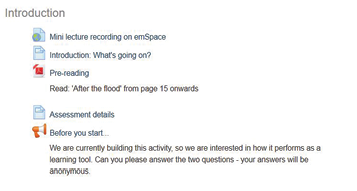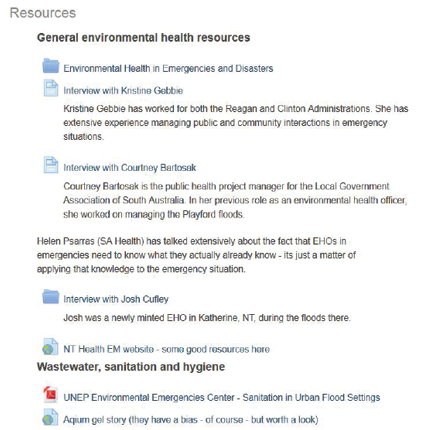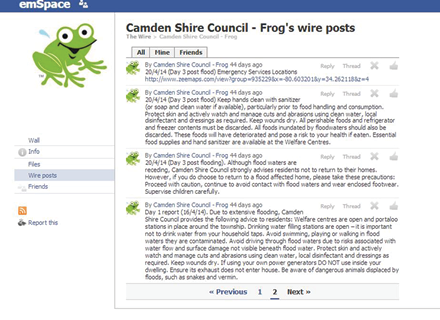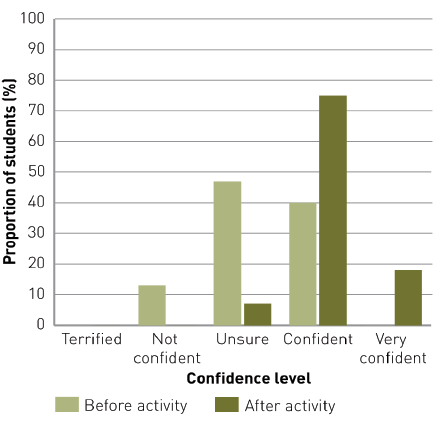Teaching students involved in emergency management how to use social media effectively
Kirsten Ross, Michael Taylor and Mitchell Fitzgerald, Flinders University,
describe a social media teaching method for public information in
emergency response.
Peer-reviewed Article
Abstract
Article
Introduction
Many students are studying towards a profession that means they are likely to have significant responsibilities in emergency situations (Noji 1996). These people may have the primary responsibly for protecting public health in emergency situations such as following floods, bushfires and cyclones and work in collaboration with the emergency response team (Markenson, Dimaggio & Redlener 2005, Landesman 2005). Social media tools can be used as one method of public communication during such events. These tools are interactive and this approach needs to be managed carefully (Lievrouw & Livingstone 2002, Wendling et al. 2013). These communication tools can be used to ensure the public is kept informed, action is appropriate, panic is minimised and public health safety is protected.
Social media is now used extensively to provide information in both public health and environmental emergency situations, including the U.S. response to the 2010 Haitian earthquake (Yates & Paquette 2011), the U.S. 2009 influenza pandemic (Merchant, Elmer & Lurie 2011), the 2010 Deepwater Horizon oil spill (Merchant, Elmer & Lurie 2011), the 2007 Californian wildfires (Sutton, Palen & Shklovski 2008), and the 2010-2011 Queensland and Victorian floods (Bird, Ling & Hayes 2012). It is important that students who will be involved in public information understand how to use these online tools effectively.
This project aimed to teach students to use these communication tools effectively, safely and legally and to examine incidents where they have been used well and used poorly. A social media site, called EmSpace, was developed on campus for this purpose.
Problem-based learning (PBL) is an ideal teaching methodology to use in situations where the ‘real-life’ scenario cannot be reproduced (Stepien & Gallagher 1993). It is suited to teaching such skills as emergency management and emergency and risk communication. PBL can significantly enhance learning as it provides a real platform for students to interact and come up with the best solutions. This project used an existing PBL activity that followed events post-flooding, where a town was subjected to a flood and it was the responsibility of the students to determine the most appropriate actions. The project followed the progress of events in a logical, sequential order, and information was provided to the students over the course of five days.
During the activity students were required to contribute to the overall emergency communication effort, including activities such as providing maps, press releases, updates and advice, and responding to public inquiries. This was done in collaboration with other students and the teaching staff. Assessment was based on the correct use of the emergency response framework and structures and the quality of the use of the communication tools.
Other teaching materials provided included examination of social media sites that have achieved good or bad responses in emergency situations, recorded interviews with people involved in emergency services communication, and interactive sessions with media educators. The PBL activity consisted of an interactive social media site, a set of pre-recorded lectures, a set of readings and notes, and a set of activities. Sequential delivery of information occurred in real-time to allow the problem-based activity to be undertaken by students over a three to five day period.
The students involved were enrolled in the Graduate Diploma of Environmental Health Practice, a postgraduate (AQF Level 8) award, at Flinders University, South Australia. This course is for students who will practice as local government environmental health officers.
Methods
The activity
The PBL activity was divided into two parts. The first (Section 1) provided students with the information and education tools they needed and a discussion space (students were required to work in groups and come up with posts as a group). The second part provided the social media site (Section 2) where students published their posts and responded to posts made by the topic co-ordinator masquerading as the public.
Section 1 included a mini lecture describing the activity to students, several pre-readings, details of the assessment and a quiz used to determine student knowledge about managing emergencies and protecting public health. It also included resources in the form of interviews with specialists, links to informative websites, the scenarios (which were delivered over three days to mimic a disaster unfolding over a week), and other resources such as mapping websites (Figure 1).
Section 2 was the online space where students posted information meant for the public over the course of the week, maps they had created showing portaloos, phone recharge points, etc (based on New Zealand response to the earthquake example), and where students responded to queries from the public (generated by the topic co-ordinator (Figure 2)).
Figure 1: Screen shots showing parts of Section 1 (the learning interface).


Figure 2: Screen shots showing parts of Section 2 (the social media site).
Student learning assessment
Two measures were used to assess student learning. The first was to ask a series of questions to determine student knowledge and their capacity to deliver information to the public in an emergency situation. All answers to these questions were anonymous. The second was assessing the product (the social media site developed by student groups). Students were given a grade (as a group) for the quality of the social media site, including the information posted and the level of interaction by the group. The question asked of students before they started the exercise was:
List things that you think might be responsibilities of an Environmental Health Officer (EHO) in an emergency situation (bushfire, flood, etc).
Each student response was given a grade out of ten. This was for project assessment purposes and the grades were not used for student grading nor were students made aware of their grade. The grade was determined by the level of detail provided in student answers, specifically looking for environmental health considerations including drinking water, toilet facilities, food safety, emerging problems such as pest control and safe asbestos removal, etc. Sample question:
How confident would you be to give advice to the general public about environmental health issues in an emergency situation? (very confident, confident, unsure, not confident, terrified)
The questions asked of students after they completed the exercise were:
List things that you think might be responsibilities of an EHO in an emergency situation (bushfire, flood, etc).
How confident would you be to give advice to the general public about environmental health issues in an emergency situation? (Ratings were very confident, confident, unsure, not confident, terrified)
How many hours (approximately) did you spend on this exercise?
What things did you like about the exercise?
What things could be improved?
The topic co-ordinators also posted (emulating public participation) throughout the exercise. This was to make the students consider the sorts of things they might be required to take responsibility for in an emergency situation. Examples of the posts include:
We are a group called the Golden Nirvanas, and we have arrived in Camden Vale to help out. There are 15 of us travelling as a group in three vans. What can we do to help?
Do I have to throw away my fridge?
I have a swimming pool in my backyard. Once I’ve chlorinated it is it ok to swim in?
I represent the local Beautify Camden Vale group. Can we use sediment deposited by flood waters in the town garden beds for replanting? How should we handle this material?
I am part of a volunteer clean up group. We have had to stop work this morning as upon clearing a large pile of branches we have discovered a body. We are concerned that close contact with materials surrounding the body may have exposed us to disease causing organisms, particularly as not all flood water has abated and water and mud splashes have occurred intermittently. What steps should we take? Is there an infection risk? What should we do?
I just saw about eight rats run out of my neighbour’s yard into a vine along my fence. What should I do?
EmSpace development
The open source social networking engine Elgg was chosen for EmSpace because the functionality best met the project needs, and because there is a strong online community that supports its development. A number of features were turned off to create silos between the dummy local government accounts so that student groups could not see each other’s work. Two extra Elgg plugins were used along with the base installation; a Facebook theme and a plugin that allowed users to login via a Learning Management System. In addition, an extra plugin was created to suit the project’s specific needs. This was the use of dummy ‘citizen’ accounts as friends to each local government account, the ability for lecturers to post as these citizens, and the ability to group students into local governments.
Full technical details related to this exercise are available at: https://empbl.flinders.edu.au/tech-specs.html.
Results
The activity
Students enjoyed the activity with responses to the question: ‘What things did you like about the exercise?’, including:
I really liked this assignment. Its [sic] very thought provoking way to implement the knowledge and information. This task made me go through many documents and I gained more information and knowledge about management of emergency situation.
The EmSpace interface was really realistic. I liked how we were guided through the process and given ideas on what would be necessary to think about on the given day. By completing this exercise I feel a lot more knowledgeable about what an EHO role is in an emergency situation.
I didn’t think I would like it but I did. It was good to have provision of the extensive materials on the site, which now gives me confidence that authoritative information is readily available on the internet. The range of questions from the ‘community’; making us have to think and communicate clearly and effectively as well as addressing our business of the moment was good. It was a good learning exercise for me.
Student learning
Student learning was measured by their responses to the question: ‘List things that you think might be the responsibilities of an EHO in an emergency situation (bushfire, flood, etc)’. Grades given for individual responses to this question rose after completing the activity, from a mean of six (SD1 = 2.6) to seven (SD = 2.5).
Student responses to the question: ‘How confident would you be to give advice to the general public about environmental health issues in an emergency situation?’ (percentage of student responses) are presented in Figure 3; notably all students were more confident after the activity.
Figure 3: Student responses to the question: ‘How confident would you be to give advice to the general public about environmental health issues in an emergency situation?’
Social media site
Students readily took to using the learning interface to develop responses prior to posting them on the social media site. The interface between the two worked seamlessly. There were a few comments that indicated that student expectations of the social media site were high:
The EmSpace site was a little clunky initially but this should not be a problem into the future, having done it once now.
The layout of EmSpace was a bit off with comments coming up as status posts.... other than that I thought it was a good exercise.
These criticisms were noted and addressed for future exercises.
Discussion
There are two primary considerations when teaching students to use social media effectively for these purposes. The first is that the students are capable of providing simple, clear, comprehensible information to the public. However social media communication is two-way. Therefore the second consideration is that the students are able to respond to posts made by the public (e.g. how to respond to panic, how to respond to the unexpected, and how to respond to tricky or nonsense posts).
This activity allowed the assessment of student posts for appropriateness and content for the general public. It also allowed student discussions to be observed behind-the-scenes. Because the discussions can be monitored asynchronously, comments and feedback can be provided regularly to student groups to guide their thinking. This is important as meaningful feedback is one of the most beneficial aspects of the learning process (Laurillard 2013, Stevens & Levi 2011, Fisher & Frey 2012). This method also gives rise to peer support and feedback, which can be more valuable in terms of learning than feedback from the assessors (O’Donnell & King 2014, Biasutti 2011).
Box 1: Scenarios as given to students
Scenario 1 (Day 1):
Camden Vale (34°15 33 N 80°36 33 W) has been flooded overnight. The floods are the result of heavy rainfall caused by the passage of a tropical cyclone (Cyclone Jamie) combined with a particularly strong La Niña period. This La Niña period had caused unusually heavy rainfall in the preceding year and subsequently the rivers and catchments surrounding Camden Vale were already at or over the maximum capacity. Additionally, high temperatures have exacerbated these conditions and driven the formation of several severe weather events.
Initially, isolated flooding began in rural areas and low-lying regions surrounding rivers. The passage of Cyclone Jamie forced water into the already overloaded system and caused extensive flooding through the Camden Vale region, which is home to approximately 20,000 people and includes commercial districts and light industrial zones. Officials report creeks and rivers being one to three metres above flood stage. Overnight, sandbagging efforts have concentrated around vulnerable areas such as the drinking water and wastewater treatment plants, although these have failed and flood water has entered both the drinking water and sewage treatment plants. Houses on the edge of the town are on septic systems. There is no power to any areas in Camden Vale and phone landlines are not working.
As part of a very large emergency services team, you will be working in the affected region. However for the purposes of this exercise, you are required to establish and monitor a social media site to provide information to the public. The primary role of the social media site is to protect public health.
Questions to get you started:
What information will you post at this initial stage?
What information should you seek out?
What sorts of questions do you think residents might have?
What are likely to be the major concerns at this stage?
Now might be an appropriate time to:
Provide advice to residents about safe drinking water and sanitation.
Scenario 2 (Day 3):
Many residents in flood-affected areas have been evacuated, although quite a few residents have either not left their houses or have returned home. Flood waters have receded to the extent that further inflows of water are no longer considered a possible danger.
Many of the acute dangers affecting the area have been either contained or removed. Some residents have begun to return to homes and businesses, primarily during the day, in order to begin clean-up efforts and assist emergency workers where they can.
There is still no electricity and phone landlines are still not working.
Now might be an appropriate time to:
Provide advice to residents about food safety and personal hygiene.
Scenario Part 3 (Day 7):
Currently gutters and some side streets are filled with a range of mixed debris as well as volumes of standing water in low-lying areas, depressions and blocked drains. The debris primarily consists of tree branches and detached structural and building material (roofing and guttering material, broken wood, glass) and mud. Due to the varied land use surrounding the area that you are working in there may be a range of further components present in this debris either contained or obscured by the muddy water. An assessment of the area may provide insight into any specific hazards that may not be immediately apparent.
Residents have started to dispose of flood debris and sediment but are unsure where to start and what should be done with debris once it is sorted from undamaged property. They have asked for some guidance in order to decide what can be kept, what can be reused, and what needs to be disposed of. Rubbish collection services have begun. There is now daily collection.
Beyond direct water damage and damage caused by debris carried by flood waters, buildings are being affected by the accumulation of water within building materials. Many structures have only received light water damage, with little to no accumulation of flood debris. However in some buildings, particularly those that contain large amounts of natural materials (wood etc), porous and absorbent goods, carpeting etc., and that have remained unoccupied and unventilated for an extended period of time, have begun to show signs of mould growth.
Clean-up efforts have proceeded well and emergency workers have begun to clear the streets. Piles of debris have been reduced rapidly as many of the local residents who have been allowed to re-enter the area have volunteered to help emergency workers when able. However, the combination of water and warm weather has resulted in high numbers of mosquitoes.
Now might be an appropriate time to:
Provide advice to residents about mosquito control (and possibly other vermin).
Provide advice to residents about safety in houses and surrounds containing mould.
Provide advice to residents about rubbish (particularly asbestos).
Conclusion
This paper illustrates how a social media site might be used in teaching an activity. Students enjoyed the activity, were engaged, and produced high quality materials for the assessable components of the activity, indicating effective learning.
References
Biasutti M 2011, The student experience of a collaborative e-learning university module. Computers & Education, 57, pp. 1865-1875. At: www.researchgate.net/profile/Michele_Biasutti/publication/220139875_The_student_experience_of_a_collaborative_e-learning_university_module/links/54243cd40cf26120b7a72a4f.
Bird D, Ling M & Haynes K 2012, Flooding Facebook-the use of social media during the Queensland and Victorian floods. Australian Journal of Emergency Management, vol. 27, no. 2, pp. 27-33.
Fisher D & Frey N 2012, Making Time for Feedback. Educational Leadership, 70, pp. 42-47.
Landesman LY 2005, Public health management of disasters: the practice guide, American Public Health Association. At: http://ajph.aphapublications.org/doi/book/10.2105/9780875530048.
Laurillard D 2013, Rethinking university teaching: A conversational framework for the effective use of learning technologies, Routledge.
Lievrouw LA & Livingstone S 2002, Handbook of new media: Social shaping and consequences of ICTs, Sage.
Markenson D, Dimaggio C & Redlener I 2005, Preparing health professions students for terrorism, disaster, and public health emergencies: core competencies. Academic Medicine, vol. 80, pp. 517-526.
Merchant RM, Elmer S & Lurie N 2011, Integrating social media into emergency-preparedness efforts. New England Journal of Medicine, vol. 365, pp. 289-291.
Noji EK 1996, The public health consequences of disasters, Oxford University Press.
O’Donnell AM & King A 2014, Cognitive perspectives on peer learning, Routledge.
Stepien W & Gallagher S 1993, Problem-based learning: As authentic as it gets. Educational leadership, vol. 50, pp. 25-25.
Stevens DD & Levi AJ 2011, Introduction to rubrics: An assessment tool to save grading time, convey effective feedback, and promote student learning, Stylus Publishing, LLC.
Sutton J, Palen L & Shklovski I 2008, Backchannels on the front lines: Emergent uses of social media in the 2007 southern California wildfires. Proceedings of the 5th International ISCRAM Conference, 2008. Washington, DC, 624-632. At: www.jeannettesutton.com/uploads/BackchannelsISCRAM08.pdf.
Wendling C, Radisch J & Jacobzone S 2013, The use of social media in risk and crisis communication. OECD Working Papers on Public Governance DOI: 10.1787/19934351. Yates D & Paquette S 2011, Emergency knowledge management and social media technologies: A case study of the 2010 Haitian earthquake. International Journal of Information Management, vol. 31, pp. 6-13.
About the authors
Kirstin Ross and Michael Taylor are lecturers in environmental health at Flinders University with an interest in emergency management and public health.
Mitchell Fitzgerald is a multimedia educational resource designer at Flinders University. He has an interest in the use of online tools for effective teaching approaches.
Footnotes
1 SD = Standard Deviation.


